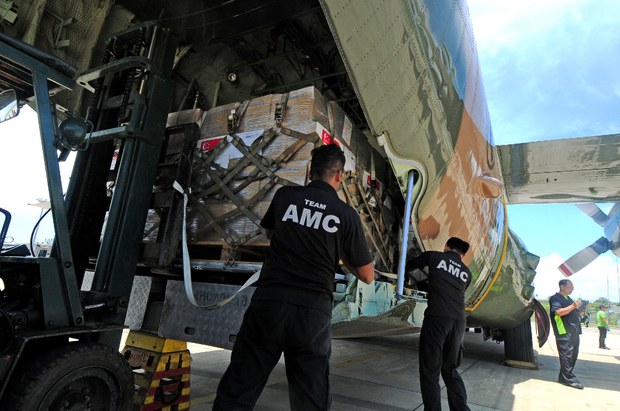Philippine Officials: No Talks On Possible US Airstrikes in Marawi
2017.08.08
Marawi, Philippines
 A Philippine Army forklift unloads a pallet of food and medicine destined for Marawi, from a Singapore Air Force transport plane at Laguindingan Airport in Misamis Oriental, Philippines, Aug. 7, 2017.
A Philippine Army forklift unloads a pallet of food and medicine destined for Marawi, from a Singapore Air Force transport plane at Laguindingan Airport in Misamis Oriental, Philippines, Aug. 7, 2017.
Philippines officials on Tuesday denied a report that the government was in talks with the United States to allow American airstrikes in the southern city of Marawi, where Filipino forces have been battling Islamic State-linked fighters since late May.
Officials from the Philippine military and defense department were commenting on an American TV news report, which said the Pentagon was considering a plan for U.S. airstrikes on enemy targets in Marawi using drones.
“[A]t present such a measure is not within the provision of the” 1951 Mutual Defense Treaty, which stipulates that the Philippines and the U.S. can come to each other’s aid in terms of external aggression, Philippine military chief Gen. Eduardo Ano said.
Manila’s defense department categorically “states that no such discussions have occurred,” Ano said in a statement.
Defense Secretary Delfin Lorenzana stressed that “no discussions regarding air strikes from whatever platforms hitting local targets” had ever transpired at his level.
However, both Lorezana and Ano said they had welcomed the U.S. military’s “desire” to help the Philippines against the militants, which took over large portions of Marawi on May 23.
So far, the U.S. has assisted the Philippines in the fighting to re-take Marawi from the militants, by sending some Special Forces personnel to the area in a non-combat role and providing aerial surveillance.
The gunmen who took over Marawi were led by Abu Sayyaf commander Isnilon Hapilon, the acknowledged leader of Islamic State (IS) in the predominantly Catholic Philippines.
He is supported by a contingent from the local Maute gang, backed in turn by foreign militants from Southeast Asia, the Middle East and elsewhere, according to the Philippine military.
The gunmen ransacked much of the city, turning the once lively lakeside Islamic city into a devastated area comparable to bomb-out cities in Syria. The Philippine military responded by bringing in hundreds of men, and by launching successive air raids.
But more than two months later, the military says it has not been able to force out gunmen entirely from Marawi, even as the death toll has kept mounting.
Bombing runs
On Monday, two Philippine Air Force jets launched fresh air strikes, rocking Marawi in early morning explosions.
Joint Task Force Marawi spokeswoman Capt. Jo-Ann Petinglay told BenarNews that at least three more soldiers had died on the battlefield, bringing the death toll on the military side to 122. Two of the soldiers were killed by a bomb.
“The fighting is concentrated now in a one square-kilometer area,” she said, adding it was difficult to place the total number of fighters believed to still be inside the danger zone.
“The remaining enemy areas cover parts of two villages in the heart of the city,” she added.
According to the military official, an estimated 80 hostages remained in the hands of enemy fighters, including the Roman Catholic priest Teresito Soganub, the vicar general of Marawi City.
This is, however, far fewer than the 300 or so hostages that President Rodrigo Duterte had said remained in the area. She did not explain the discrepancy.
She placed rebel fatalities at 528, while 45 civilians had been killed so far.
No mention from Tillerson
Tuesday’s statement from the defense department, which was reacting to the report by NBC News on Monday, said that although Philippines-U.S. counter-terrorist relations were on track, the American assistance in Marawi was limited to technical assistance, surveillance, information gathering and training.
U.S. Secretary of State Rex Tillerson, who was attending the ASEAN Regional Forum in Manila on Monday, did not mention the possibility of the United States intervening in Marawi through airstrikes.
He stressed that that U.S. military help had been restricted to been restricted to a non-combat role.
“As you know, most of what we’re providing them is information, some surveillance capabilities with some recent transfers of a couple of Cessnas and a couple of UAVs to allow them to have better information in which to conduct the fight down there,” Tillerson told reporters.
“We’re providing them some training and some guidance in terms of how to deal with an enemy that fights in ways that is not like most people have ever had to deal with,” Tillerson told reporters.
The top U.S. diplomat also described the situation in Marawi as a “tragic” one that could take an uncertain turn.
“We think they are beginning to get that situation under control, but the real challenge is going to come with once they have the fighting brought to an end how to deal with the conditions on the ground and ensure it does not re-emerge,” the secretary said.
Felipe Villamor in Manila contributed to this report.







